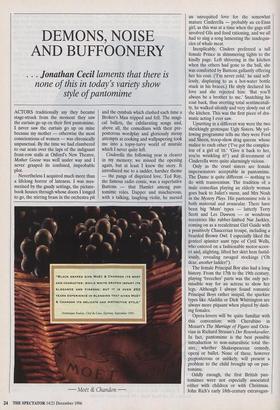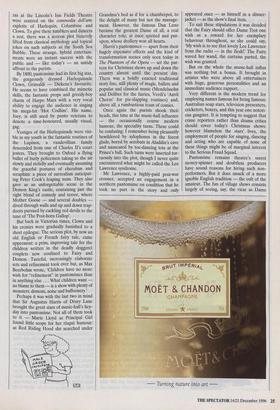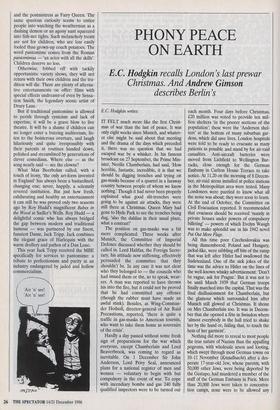DEMONS, NOISE AND BUFFOONERY
. . . Jonathan Cecil laments that there is
none of this in today's variety show style of pantomime
ACTORS traditionally say they became stage-struck from the moment they saw the curtain go up on their first pantomime. I never saw the curtain go up on mine because my mother — otherwise the most conscientious of women — was chronically unpunctual. By the time we had clambered to our seats over the laps of the indignant front-row stalls at Oxford's New Theatre, Mother Goose was well under way and I never grasped its confused, improbable plot.
Nevertheless I acquired much more than a lifelong horror of lateness. I was mes- merised by the gaudy settings, the picture- book houses through whose doors I longed to go, the stirring brass in the orchestra pit and the cymbals which clashed each time a Broker's Man tripped and fell. The magi- cal ballets, the exhilarating songs and, above all, the comedians with their pre- posterous wordplay and gloriously messy attempts at cooking and wallpapering took me into a topsy-turvy world of misrule which I never quite left.
Cinderella the following year is clearer in my memory; we missed the opening again, but at least I knew the story. It introduced me to a sadder, harsher theme — the pangs of disprized love. Ted Ray, the famous radio comic, was a superlative Buttons — that Hamlet among pan- tomime roles. Dapper and mischievous, with a talking, laughing violin, he nursed an unrequited love for the somewhat mature Cinderella — probably an ex-Ensa girl, as this was at a time when the gags still involved GIs and food rationing, and we all had to sing a song lamenting the inadequa- cies of whale meat.
Inexplicably, Cinders preferred a tall female Prince in shimmering tights to the kindly page. Left shivering in the kitchen when the others had gone to the ball, she was comforted by Buttons gallantly offering her his coat. (I'm never cold,' he said self- lessly, displaying to us a hot-water bottle stuck in his braces.) He shyly declared his love and she rejected him: 'But you'll always be a brother to me.' Snatching his coat back, thus averting total sentimentali- ty, he walked silently and very slowly out of the kitchen. This was the first piece of dra- matic acting I ever saw.
Upsetting in a different way were the two shriekingly grotesque Ugly Sisters. My yel- lowing programme tells me they were Ford and Sheen, troop-show drag queens whose malice to each other ('I've got the complex- ion of a girl of 16.'Give it back to her, you're wrinkling it!) and ill-treatment of Cinderella were quite alarmingly vicious.
Only as the cruel sisters are female impersonators acceptable in pantomime. The Dame is quite different — nothing to do with transvestism. The tradition of a male comedian playing an elderly woman goes back to Juliet's nurse, and Mrs Noah in the Mystery Plays. His pantomime role is both maternal and avuncular. There have been big 'Mum' types — latterly Terry Scott and Les Dawson — or wondrous eccentrics like rubber-limbed Nat JacIdey, coming on as a recalcitrant Girl Guide with a positively Chaucerian troupe, including a bearded Brown Owl. I especially liked the genteel spinster aunt type of Cyril Wells, who entered on a fashionable motor-scoot- er and, alighting, lifted her skirt hem fastid- iously, revealing ravaged stockings (`Oh dear, another ladder!).
The female Principal Boy also had a long history. From the 17th to the 19th century, playing 'breeches' parts was the only per- missible way for an actress to show her legs. Although I always found romantic Principal Boys rather insipid, the sparkier types like Aladdin or Dick Whittington are always more piquant when played by dash- ing females.
Opera-lovers will be quite familiar with this convention: with Cherubino in Mozart's The Marriage of Figaro and Octa- vian in Richard Strauss's Der Rosenkavalier. In fact, pantomime is the best possible introduction to non-naturalistic total the- atre, whether Shakespearean comedy, opera or ballet. None of these, however preposterous or unlikely, will present a problem to the child brought up on pan- tomime.
Oddly enough, the first British pan- tomimes were not especially associated either with children or with Christmas. John Rich's early 18th-century extravagan- zas at the Lincoln's Inn Fields • Theatre were centred on the commedia dell'arte exploits of Harlequin, Columbine and Clown. To give these tumblers and dancers a rest, there was a serious plot bizarrely lifted from classical mythology and topical jokes on such subjects as the South Sea Bubble. These strange, hybrid entertain- ments were an instant success with the public and — like today's — an untidy affront to the purists.
By 1800, pantomime had its first big star, the gorgeously dressed Harlequinade Clown, Grimaldi — Dickens's favourite. He seems to have combined the mimetic skills, the fantastic props and greedy-boy charm of Harpo Marx with a very vocal ability to engage the audience in singing his mega-hit 'Hot Codlins'. His name, Joey, is still used by panto veterans to denote a time-honoured, usually visual, gag.
Vestiges of the Harlequinade were visi- ble in my youth in the fantastic routines of the Lupinos, a vaudevillian family descended from one of Charles II's court jesters. They brought to Oxford a flying ballet of burly policemen taking to the air slowly and stolidly and eventually assuming the graceful postures of cherubim and seraphim: a piece of surrealism anticipat- ing Peter Cook's leaping nuns. They also gave us an unforgettable scene in the Demon King's castle, containing just the right blend of comedy and terror, where Mother Goose — and several doubles — dived through walls and up and down trap- doors pursued by cackling red devils to the tune of 'The Post-horn Gallop'.
But back in Victorian times, Clown and his cronies were gradually banished to a short epilogue. The serious plot, by now an old English or French fairy tale, came uppermost: a prim, improving tale for the children written in the deadly doggerel couplets now confined to Fairy and Demon. Tasteful, increasingly elaborate sets and refinement took over but, as Max Beerbohm wrote, 'Children have no more wish for "refinement" in pantomimes than in anything else. . . What children want — no blame to them — is a show with plenty of monsters, demons, noise and buffoonery.'
Perhaps it was with the last two in mind that Sir Augustus Harris of Drury Lane brought the great stars of music-hall's hey- day.into pantomime. Not all of them took to It — Marie Lloyd as Principal Girl found little scope for her risque humour: as Red Riding Hood she searched under Grandma's bed as if for a chamberpot, to the delight of many but not the manage- ment. However, the famous Dan Leno became the greatest Dame of all, a real character role, at once spirited and put- upon, whose drollery won all hearts.
Harris's pantomimes — apart from their hugely expensive effects and the kind of transformation scenes only seen today in The Phantom of the Opera — set the pat- tern for Christmas shows up and down the country almost until the present day. There was a boldly enacted traditional story line, still plenty of magic, ballets and popular and classical music (Mendelssohn and Delibes for the fairies, Verdi's 'Anvil Chorus' for pie-slapping routines) and, above all, a rumbustious team of comics.
Once again the purists shook their heads, this time at the music-hall influence — the occasionally coarse modern humour, the speciality turns. These could be confusing: I remember being pleasantly bewildered by xylophones in the forest glade, bored by acrobats in Aladdin's cave and nauseated by toe-dancing tots at the Prince's ball. Such turns were inserted tor- tuously into the plot, though I never quite encountered what might be called the Lee Lawrence syndrome.
Mr Lawrence, a highly-paid post-war crooner, accepted an engagement in a northern pantomime on condition that he took no part in the story and only appeared once — as himself in a dinner- jacket — as the show's final item.
To suit these stipulations it was decided that the Fairy should offer Dame Trot one wish as a reward for her exemplary behaviour throughout, so she could say, 'My wish is to see that lovely Lee Lawrence from the radio — in the flesh!' The Fairy waved her wand, the curtains parted, the wish was granted.
But on the whole the music-hall influx was nothing but a bonus. It brought in artistes who were above all entertainers with huge, generous personalities and an immediate audience rapport.
Very different is the modern trend for employing names famous for being famous: Australian soap stars, television presenters, cricketers, boxers, and this year one notori- ous gangster. It is tempting to suggest that crime reporters rather than drama critics should cover today's Christmas shows: however blameless the stars' lives, the employment of people for singing, dancing and acting who are capable of none of these things might be of marginal interest to the Serious Fraud Squad.
Pantomime remains theatre's surest money-spinner and doubtless producers have sound reasons for hiring such non- performers. But it does smack of a more ignoble English tradition — the cult of the amateur. The fun of village shows consists largely of seeing, say, the vicar as Dame and the postmistress as Fairy Queen. The same spurious curiosity seems to entice people into watching the weatherman as a dashing demon or an agony aunt squeezed into fish-net tights. Such melancholy treats are not for children, who are less easily fooled than grown-up couch potatoes. The word pantomime comes from the Roman pantomimus — 'an actor with all the skills'. Children deserve no less.
Otherwise, fobbed off with tackily opportunistic variety shows, they will not return with their own children and the tra- dition will die. There are plenty of alterna- tive entertainments on offer: films with special effects undreamt-of even by Sensa- tion Smith, the legendary scenic artist of Drury Lane.
But if traditional pantomime is allowed to perish through cynicism and lack of expertise, it will be a grave blow to live theatre. It will be a shame if children can no longer enter a buzzing auditorium, lis- ten to the boisterous overture, and laugh hilariously and quite irresponsibly with their parents at routines handed down, polished and streamlined by generations of clever comedians. Where else — as the song nearly said — are the clowns?
What Max Beerbohm called, with a touch of irony, 'the only art-form invented in England' has always been a bastardised, changing one; never, happily, a solemnly revered institution. But just how fresh, exhilarating and healthy an entertainment it can still be was proved only two seasons ago by Roy Hudd's magnificent Babes in the Wood at Sadler's Wells. Roy Hudd — a delightful comic who has always bridged the gap between modern and traditional humour — was partnered by our finest, funniest Dame, Jack Tripp. Jack combines the elegant grace of Harlequin with the warm drollery and pathos of a Dan Leno.
This year Jack Tripp received the MBE specifically for services to pantomime: a tribute to perfectionism and purity in an industry endangered by jaded and hollow commercialism.




















































































































 Previous page
Previous page